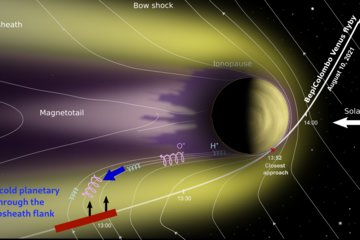All genres
101.
Journal Article
Current density models of the eastward electrojet derived from ground-based magnetic field and radar measurements. Journal of Atmospheric and Terrestrial Physics 56, pp. 81 - 91 (1994)
102.
Journal Article
Combined measurements of EISCAT and the EISCAT magnetometer cross to study Ω bands. Journal Geophysical Research 99 (A5), pp. 8951 - 8959 (1994)
103.
Journal Article
Nonlinear evolution of TID's spectra in the auroral ionosphere. Chinese J. Geophys. 36, pp. 447 - 457 (1994)
104.
Journal Article
On incoherent scatter plasma lines in aurorae. Journal Geophysical Research 99 (A6), pp. 11391 - 11399 (1994)
105.
Journal Article
Observation of the modified two-stream plasma instability in the midlatitude E region ionosphere. Journal Geophysical Research 99 (A4), pp. 6219 - 6226 (1994)
106.
Journal Article
Particle-in-cell plasma simulations of the modified two-stream instability. Annales Geophysicae 12 (10), pp. 1091 - 1100 (1994)
107.
Journal Article
A 50-MHz radio Doppler experiment for midlatitude E region coherent backscatter studies: System description and first results. Radio Science 28, pp. 959 - 978 (1993)
108.
Journal Article
Some observations of radio auroral backscatter at 140 MHz during E-region electron gas heating. Annales Geophysicae 11, pp. 283 - 295 (1993)
109.
Journal Article
Modellsimulationen zur Interpretation von TIDs in hohen Breiten. Kleinheubacher Berichte 36, pp. 399 - 408 (1993)
110.
Journal Article
Nonlinear wave-wave interactions related to gravity wave reflection in the auroral upper F-region observed with the EISCAT radar. Journal of Atmospheric and Terrestrial Physics 55, pp. 719 - 738 (1993)
111.
Journal Article
Nonlinear evolution of TID's spectra in the auroral ionosphere. Acta Geophysica Sinica 36, pp. 699 - 709 (1993)
112.
Journal Article
Vertical structure of AGW associated ionospheric fluctuations in the E- and lower F-region observed with EISCAT - A case study. Journal of Atmospheric and Terrestrial Physics 55, pp. 739 - 749 (1993)
113.
Journal Article
On type 3 auroral VHF coherent radar backscatter. Journal Geophysical Research 97, pp. 4109 - 4120 (1992)
114.
Journal Article
The ionospheric response to perturbation electric fields during the onset phase of geomagnetic storms. Canadian Journal of Physics 70, pp. 575 - 581 (1992)
115.
Journal Article
A high-resolution model for the ionospheric F-region at mid- and high-latitude sites. Annales Geophysicae 10, pp. 577 - 596 (1992)
116.
Journal Article
EISCAT results during the ROSE campaign and comparison with STARE measurements. Journal of Atmospheric and Terrestrial Physics 54, pp. 733 - 739 (1992)
117.
Journal Article
Ionospheric responses to atmospheric grvity waves in various plasma quantities and inversion of GW's parameters. Acta Geophysica Sinica 35, pp. 405 - 414 (1992)
118.
Journal Article
Gravity wave parameters derived from traveling ionospheric disturbances observations in the auroral zone. Journal of Atmospheric and Terrestrial Physics 27, pp. 829 - 840 (1992)
119.
Journal Article
The E-region rocket/radar instability study (ERRRIS): scientific objectives and campaign overview. Journal of Atmospheric and Terrestrial Physics 54, pp. 779 - 808 (1992)
120.
Journal Article
The ROSE project. Scientific objectives and discussion of first results. Journal of Atmospheric and Terrestrial Physics 54, pp. 657 - 667 (1992)











